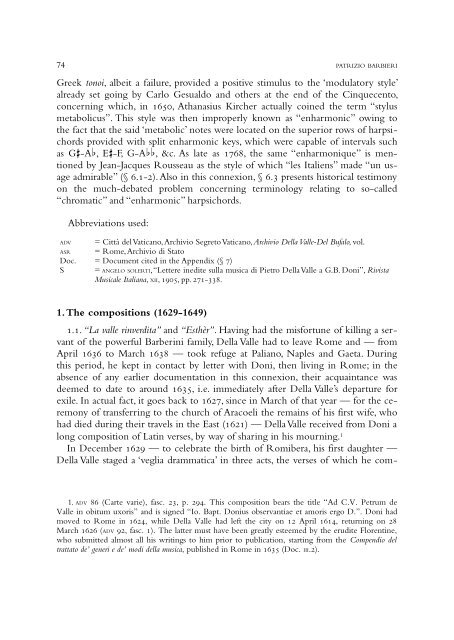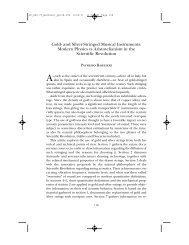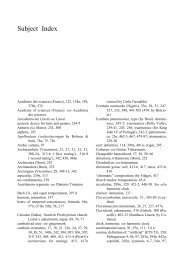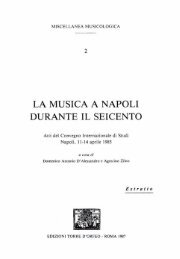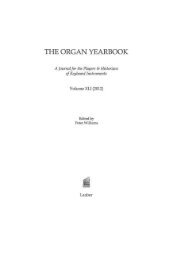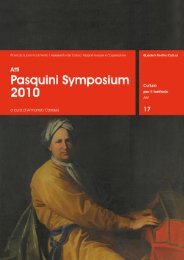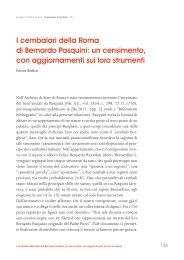You also want an ePaper? Increase the reach of your titles
YUMPU automatically turns print PDFs into web optimized ePapers that Google loves.
74 PATRIZIO BARBIERI<br />
Greek tonoi, albeit a failure, provided a positive stimulus to the ‘modulatory style’<br />
already set going by Carlo Gesualdo and others at the end of the Cinquecento,<br />
concerning which, in 1650, Athanasius Kircher actually coined the term “stylus<br />
metabolicus”. This style was then improperly known as “enharmonic” owing to<br />
the fact that the said ‘metabolic’ notes were located on the superior rows of harpsichords<br />
provided with split enharmonic keys, which were capable of intervals such<br />
as G8-A7, E8-F, G-A77, &c. As late as 1768, the same “enharmonique” is mentioned<br />
by Jean-Jacques Rousseau as the style of which “les Italiens” made “un usage<br />
admirable” (§ 6.1-2). Also in this connexion, § 6.3 presents historical testimony<br />
on the much-debated problem concerning terminology relating to so-called<br />
“chromatic” and “enharmonic” harpsichords.<br />
Abbreviations used:<br />
ADV = Città del Vaticano, Archivio Segreto Vaticano, Archivio Della Valle-Del Bufalo, vol.<br />
ASR = Rome, Archivio di Stato<br />
Doc. = Document cited in the Appendix (§ 7)<br />
S = ANGELO SOLERTI, “Lettere inedite sulla musica di Pietro Della Valle a G.B. Doni”, Rivista<br />
Musicale Italiana, XII, 1905, pp. 271-338.<br />
1. The compositions (1629-1649)<br />
1.1. “La valle rinverdita” and “Esthèr”. Having had the misfortune of killing a servant<br />
of the powerful Barberini family, Della Valle had to leave Rome and — from<br />
April 1636 to March 1638 — took refuge at Paliano, Naples and Gaeta. During<br />
this period, he kept in contact by letter with Doni, then living in Rome; in the<br />
absence of any earlier documentation in this connexion, their acquaintance was<br />
deemed to date to around 1635, i.e. immediately after Della Valle’s departure for<br />
exile. In actual fact, it goes back to 1627, since in March of that year — for the ceremony<br />
of transferring to the church of Aracoeli the remains of his first wife, who<br />
had died during their travels in the East (1621) — Della Valle received from Doni a<br />
long composition of Latin verses, by way of sharing in his mourning. 1<br />
In December 1629 — to celebrate the birth of Romibera, his first daughter —<br />
Della Valle staged a ‘veglia drammatica’ in three acts, the verses of which he com-<br />
1. ADV 86 (Carte varie), fasc. 23, p. 294. This composition bears the title “Ad C.V. Petrum de<br />
Valle in obitum uxoris” and is signed “Io. Bapt. Donius observantiae et amoris ergo D.”. Doni had<br />
moved to Rome in 1624, while Della Valle had left the city on 12 April 1614, returning on 28<br />
March 1626 (ADV 92, fasc. 1). The latter must have been greatly esteemed by the erudite Florentine,<br />
who submitted almost all his writings to him prior to publication, starting from the Compendio del<br />
trattato de’ generi e de’ modi della musica, published in Rome in 1635 (Doc. III.2).


